Understanding Skateboard Decks and Griptape Explained
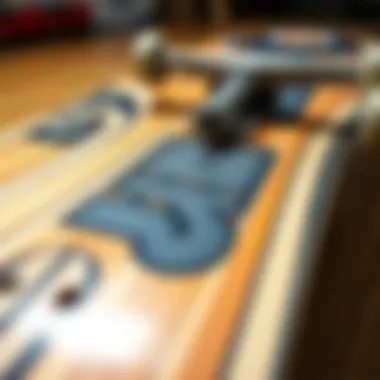
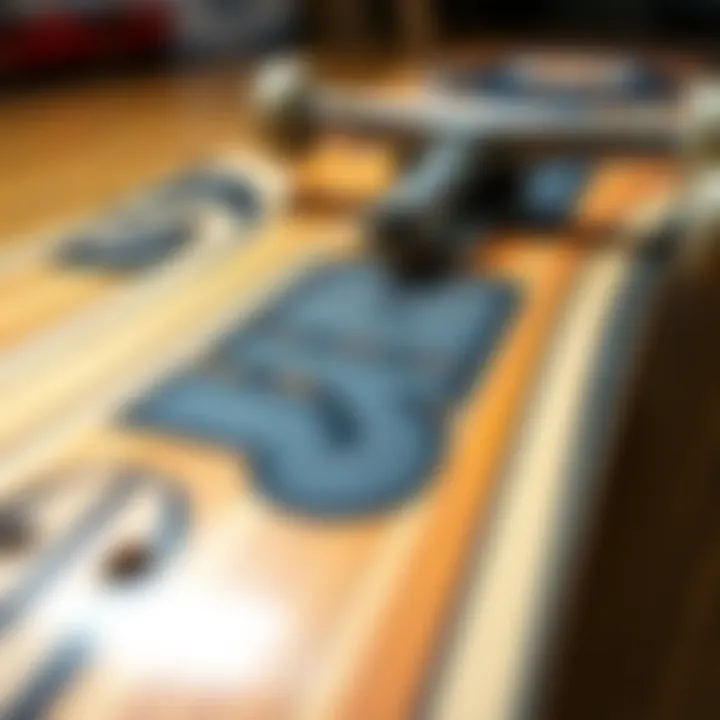
Intro
Skateboarding has evolved from its humble beginnings into a complex sport that blends art, skill, and physics. At the heart of this discipline lies the skateboard deck, an unsung hero that shapes the very experience of riding. Add griptape to the equation, and you’ve got a dynamic duo that can significantly affect performance. This guide takes a closer look at what makes skateboard decks and griptape so vital, diving deep into materials, styles, maintenance, and their impactful interplay.
Skills Development
When it comes to skateboarding, the journey of skill development often begins with the relationship between the rider and their deck. Understanding how to use the deck effectively can be the difference between mastering a trick and hitting the pavement.
Trick Tutorials
Learning new tricks is a rite of passage for many skateboarders. Whether it's the classic ollie or more complicated moves like the kickflip, the deck's responsiveness can significantly enhance your practice sessions. Here’s a simple tutorial for one foundational trick:
Ollie
- Position your back foot on the tail of the board.
- With your front foot, find a comfortable spot near the middle of the deck.
- Push down on the tail sharply while sliding your front foot up towards the nose.
- As the board comes up, jump slightly to ensure your knees clear the deck.
- Land softly, bending your knees to absorb the impact.
This trick showcases how the deck's construction can influence both technique and progression.
Skill Progression Tips
As skills advance, so too should the understanding of the equipment. Here are some pointers to foster growth:
- Experiment with Deck Size: Different widths and lengths impact how well you can control the board.
- Explore Griptape Varieties: Different textures offer varying levels of traction which can affect your balance.
- Seek Feedback: Having experienced skaters critique your style can shed light on areas for improvement.
As skaters grow, their decks should evolve too, aligning with their increasingly sophisticated trick repertoire.
Gear Insights
Understanding skateboard gear is essential for safety and performance. Skateboard reviews often highlight the best models suited for both beginners and advanced riders. Notably, brands like Element and Santa Cruz have long had a reputation for durable skateboards.
Safety Equipment Recommendations
No one sets out to experience an injury, but accidents happen frequently in skateboarding. Ensuring one’s safety gear is in top shape is just as crucial as choosing the right deck. Here are some essentials:
- Helmet: Always wear a certified helmet to protect against head injuries. Brands such as Triple Eight offer reliable options.
- Wrist Guards: Invest in good wrist guards to prevent sprains. Many skaters overlook this, but they can really save you.
- Knee Pads: Cushion your falls and avoid scrapes by sporting knee pads, especially for tricks that induce greater risk.
By combining the right gear with an awareness of the skateboard deck and griptape intricacies, riders can refine their skills while ensuring their safety.
Epilogue
This article endeavors to give you an understanding of how skateboard decks paired with the right griptape can elevate your performance. With insight into skateboarding skills, safety gear, and the multitude of deck styles out there, you're now equipped to make informed decisions as you venture further into the world of skateboarding. Remember, every ride is a lesson, every trick a building block, and each fall simply a step towards improvement.
For additional insights on this topic, consider checking resources from Wikipedia, Britannica, and discussions on Reddit.
Prelims to Skateboard Decks
Skateboarding is more than just a sport; it's a culture, an art form, and a way of life. The skateboard deck forms the very soul of this intricate world. It's not merely a piece of wood but the foundation upon which tricks are executed and creativity is unleashed. Understanding the nuances of skateboard decks is vital for both novices and seasoned riders alike.
A skateboard deck is designed not only to accommodate the rider's weight but to enhance their skating experience, allowing for varied styles and techniques. Familiarity with the types and shapes of decks can significantly influence a rider's performance and enjoyment. With the right deck, a skater can maneuver effortlessly through urban landscapes or carve smooth lines in a bowl setup.
In this section, we will delve into the definition, purpose, and various types of skateboard decks. Knowing what each type brings to the table can make all the difference in selecting the right board for individual needs.
Definition and Purpose
The skateboard deck is commonly defined as the flat board that forms the main part of a skateboard, typically made of wood or composite material. It is engineered to provide a stable surface for riders to stand on while performing tricks or simply cruising around. The deck’s design impacts balance, control, and overall skating experience. Essentially, the deck serves as both a platform for the rider and a tool for expressing style.
Types of Skateboard Decks
Skateboard decks come in various shapes and sizes, each catering to specific riding styles. Understanding these types can help skaters identify the deck that resonates with their needs:
- Cruiser Decks: Cruiser decks are typically wider and have a more elongated shape, making them ideal for casual rides. The core characteristic of these decks is their ability to provide a smooth ride over rough terrains. They're perfect for commuting or leisurely rides in the park. The unique feature of cruiser decks lies in their versatility; they handle speed well and offer a comfortable stance. The downside is that they may not be ideal for performing complex tricks due to their larger size.
- Shortboards: Shortboards are the small, often lighter variants designed for tricks and stunts. Their shorter length allows skaters to execute flip tricks and technical maneuvers with precision. A key characteristic is their responsiveness, enabling quick turns and swift adjustments while in motion. These decks excel in skate parks and urban environments. However, they may be less comfortable for long distances due to their design, making them suited more for performance than transportation.
- Longboards: Longboards differ significantly from traditional skateboards in both shape and size, typically featuring a greater length and a wider construction. They provide superior stability, making them excellent for downhill rides or cruising. The notable characteristic is the larger wheelbase, which offers enhanced control at higher speeds. However, this extra size can make tricks more challenging. Longboards are favored for their comfortable ride over distance but are not usually used for technical street tricks.
- Freestyle Decks: Freestyle decks are tailored for riders who enjoy creativity and varied trick execution on flat ground. These decks are often symmetrical, allowing skaters to ride in either direction. The standout feature is their lightness, which promotes easier manipulation. They’re particularly advantageous for performing tricks, yet may lack stability when compared to other deck types which can be a downside for beginners.
In brief, selecting a skateboard deck goes beyond just preference; it involves understanding personal style, riding environment, and skill level. Each deck type supports unique riding experiences, shaping one's journey in the vibrant world of skateboarding.
The Role of Griptape
Griptape is more than just a strip of sandpaper stuck to a skateboard deck; it is an integral component that significantly impacts a rider's performance. Without it, a skateboard deck would essentially be just a smooth surface, and skaters would struggle to maintain control. In essence, griptape ensures that riders stay glued to their boards, allowing for a seamless fusion of power and precision in every trick.
Functionality of Griptape
The primary function of griptape centers on providing traction. This traction enhances the skater's ability to maneuver their board efficiently. When skaters ollie or attempt flips, the grip of the tape allows their feet to stay in place. This function becomes critical when landing tricks, as a solid grip aids in controlling the board to avoid flips that could result in falls or lost balance.
Moreover, griptape's surface can vary. Some varieties feature rough textures while others are less abrasive, providing options depending on personal preference or skating style. The choice of griptape can also influence the feedback a skater receives; a grittier surface can increase confidence as it creates a more secure base for tricks.
Benefits of Using Griptape
Enhanced Grip and Control
A key aspect of enhanced grip and control is the traction that griptape provides during skating. This is especially important during high-speed maneuvers or complicated tricks. The unique feature of griptape is its rough, abrasive surface, which helps the skateboarder maintain their footing.
It's a popular choice among riders aiming to enhance their performance as it allows for better control during twists and turns. However, griptape can wear down over time if subjected to frequent use, requiring regular checks and replacement to maintain optimal grip.
Stability and Safety
Stability is paramount when it comes to skateboarding, particularly for those executing advanced tricks. The characteristic of stability provided by griptape significantly enhances overall safety. Skaters can execute tricks with more confidence, knowing that their feet are unlikely to slip.
This aspect makes a big difference, especially for beginners, who might be apprehensive about trying new tricks. If the griptape is in good shape, skaters are less likely to experience falls. Nonetheless, it’s essential to remember that worn-out griptape may compromise safety, thus it’s critical to replace it when needed.
Personalization Options
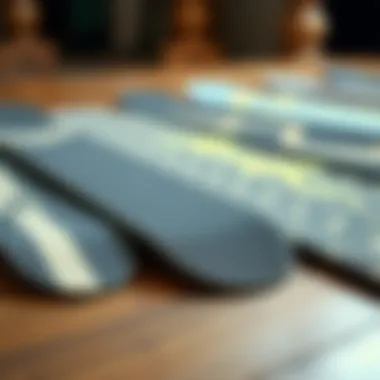
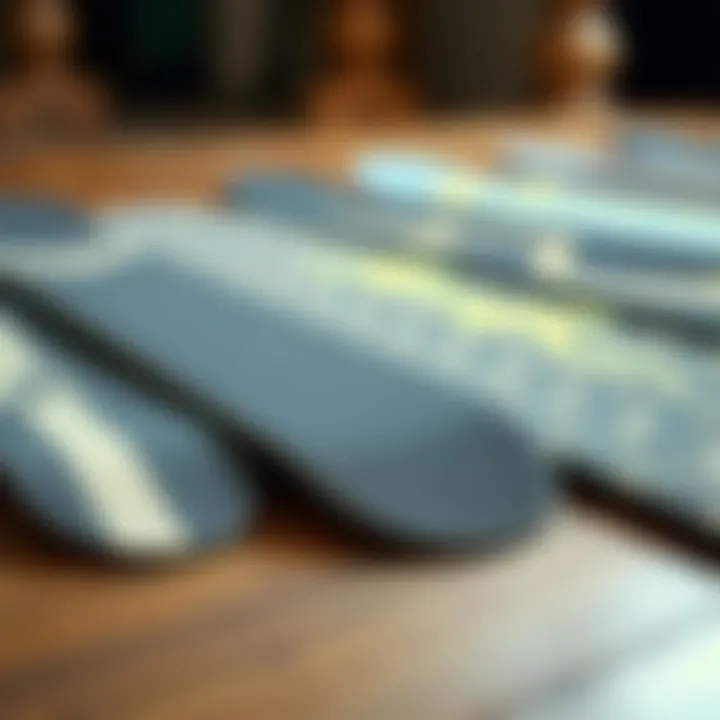
Personalization opens up a world of creativity and individuality for skateboarders. Griptape is available in a wide range of designs—from simple, clear tapes to those adorned with vivid graphics or patterns. This aspect allows skaters to express their personalities and style.
For a deck that reflects personal taste, customized griptape becomes a medium for self-expression. However, it’s essential to examine the trade-off between aesthetics and functionality; some graphic tapes can sacrifice grip for style, so choosing a well-balanced option is key.
Griptape, in this sense, serves not just a functional role, but also strengthens the visual identity of each skateboard.
"In the wild world of skateboarding, griptape makes the difference between a smooth ride and a wipeout."
By joining functionality with aesthetic appeal, griptape significantly enhances the overall experience of skateboarding, providing skaters not only the grip they need but also the flair they desire.
For more information on various griptape types, customization ideas, and how they can enhance your skating experience, consider visiting Wikipedia on Skateboarding or checking discussion threads on Reddit.
As we continue to explore the various elements that contribute to a skateboard's overall effectiveness, griptape remains a topic worth diving deeper into.
Material Considerations
When it comes to skateboarding, the choice of materials for both the deck and griptape plays a pivotal role. Understanding these materials not only helps skaters to select the right equipment but also influences their overall riding experience, including performance and durability. Each type of material has its own characteristics, advantages, and potential drawbacks. This section will break down the materials used in deck construction and griptape, allowing for a more informed choice when assembling or upgrading a skateboard.
Materials for Deck Construction
Skateboard decks are primarily made of three main materials: maple wood, bamboo, and plastic composites. Each material brings its own flavor to the skating experience, shaping how the board feels, performs, and endures.
Maple Wood
Maple wood is perhaps the most recognized material for skateboard decks. It is tough yet lightweight, providing a mix of durability and flexibility. The key characteristic of maple is its density, which offers superior pop and responsiveness when jumping or executing tricks. A significant benefit of using maple wood is its ability to withstand the wear and tear that comes with skateboarding. However, it does absorb moisture more than other materials, which can lead to a degradation of the deck over time if not properly maintained. In summary, maple is beloved for its balance between strength and performance.
Bamboo
Bamboo decks have gained traction for their lightweight nature and eco-friendliness. The flexibility of bamboo contributes to a unique riding experience, making it great for cruisers. The main feature distinguishing bamboo from other materials is its natural shock-absorption capabilities, which can help reduce fatigue during longer rides. Riders appreciate bamboo decks for their sustainability, as bamboo grows rapidly compared to traditional lumber. However, they may not provide the same level of stiffness as maple, which can be a drawback for those looking for high-impact performance.
Plastic Composites
Plastic composites offer a different take on skateboarding materials. These decks are often more robust in wet conditions, making them a popular choice for rider who skate in variable weather. The primary advantage of plastic composites is their resistance to cracking and warping. While they may not deliver the same level of "pop" as wood, they offer a consistent ride and can be customized in color and design without the constraints of traditional materials. On the flip side, they might lack the nostalgic feel many skaters associate with wooden decks.
Griptape Materials
Just as the deck material is crucial, the type of griptape used can significantly affect the skateboarding experience. Griptape comes in several varieties, including abrasive, foam, and clear griptape, each catering to different needs and preferences.
Abrasive Griptape
Abrasive griptape is the standard choice for most boarders. It features a rough surface that allows for maximum traction, which is essential for performing tricks and ensuring stability. The main characteristic of this type of griptape is its durability – it withstands heavy use without losing grip. For many skaters, its reliability makes it a preferred option. However, one downside is the rough texture can cause wear on shoes over time, which some riders may find troublesome.
Foam Griptape
Foam griptape presents a softer alternative. Its comfort is a significant benefit, making it ideal for those who work on balance and agility rather than tricks. Foam is less abrasive, which can preserve the life of shoes, but it may not offer as much grip as its abrasive counterpart. Many casual riders prefer foam for a smooth ride, but it’s not ideal for tricks requiring solid footing.
Clear Griptape
Clear griptape serves a unique purpose, allowing the skateboard's artwork to shine through while still providing the necessary grip. It’s a common choice among skaters who wish to showcase their deck’s design. The primary feature of clear griptape is its ability to offer decent grip without masking the aesthetic of the board. However, this type usually wears out quicker than its opaque counterparts, leading to potential need for replacement sooner than expected.
Choosing the right materials for both your skateboard deck and griptape can greatly affect your riding performance and comfort. Understanding these elements can help elevate your skateboarding experience to new heights.
Choosing the Right Skateboard Deck
Selecting the right skateboard deck is like picking the right shoes for a dance—it significantly influences the way you perform. The deck serves as the platform that supports all the tricks and movements a skateboarder wants to execute. A proper deck merges comfort with performance, enabling the skater to hone their skills and express their style effectively. Thus, understanding the nuances of size and shape is crucial for both beginners and seasoned riders.
Size Considerations
When it comes to skateboard decks, size truly matters. Most decks range from 7.5 inches to 8.75 inches in width. A narrower deck is generally suited for technical tricks, while a wider deck allows for greater stability, making it an ideal choice for those starting out or focusing on vert skateboarding.
Key Points about Size:
- Personal Preference: Individual comfort is paramount. Some skaters prefer a snug fit, while others lean toward a broader stance.
- Foot Size: Larger feet may benefit from wider decks, enhancing foot placement during tricks.
- Skating Style: Street skaters usually opt for narrower decks for easier maneuverability, whereas park or downhill skaters might choose wider setups for increased stability.
By assessing these factors, skaters can select a deck that aligns with their unique style and enhances their overall skateboard experience.
Shape Preferences
The shape of a skateboard deck is not just about looks—it's about performance. Understanding the specific nuances of different shapes can transform how a rider approaches the skateboard, impacting everything from stability to trick execution.
Different Nose and Tail Shapes
The nose and tail of a skateboard shape dictate handling and maneuverability. Generally, a more pronounced nose offers better leverage for performing tricks, while a kicktail helps in lifting the board off the ground for ollies and flip tricks. Skaters often favor decks with a steep kicktail, enabling more explosive takeoffs for aerial stunts.
Key Characteristics of Nose and Tail Shapes:
- Steeper Angles: Better versatility for tricks and turns.
- Technical Tricks: Tricks requiring more pop benefit from well-defined tail identities.
- Stable Landings: A larger contact area gives reassurance during landings.
Thus, the offerings in nose and tail shapes contribute to not only aesthetic appeal but also functional performance throughout a skater's journey.
Concave Depth Variations
Concave depth is another influential aspect of skateboard design. It's the curve of the board, which affects how a skateboarder feels in relation to their board. A deeper concave keeps your feet locked in place during aggressive turns and tricks, while a flat or mellow concave allows for easier foot adjustments, crucial for beginners practicing balance.
Advantages of Concave Depth Variations:
- Deeper Concave: Enhances grip and stability, providing the confidence needed for complex maneuvers.
- Shallower Concave: Facilitates easier foot movement, catering to those just getting the hang of skateboarding.
In essence, while it might seem like a small detail, the concave depth offers significant influence on control and execution, pivotal aspects for any skateboarder.
"Choosing the right skateboard deck not only influences your comfort but your ability to master various tricks and styles. It's a personal journey in your skating experience."
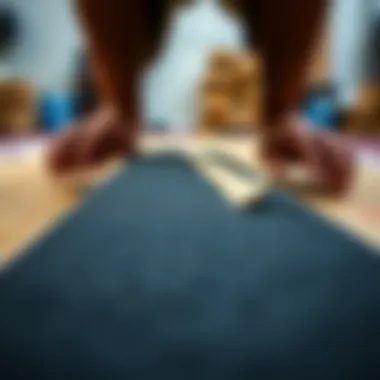
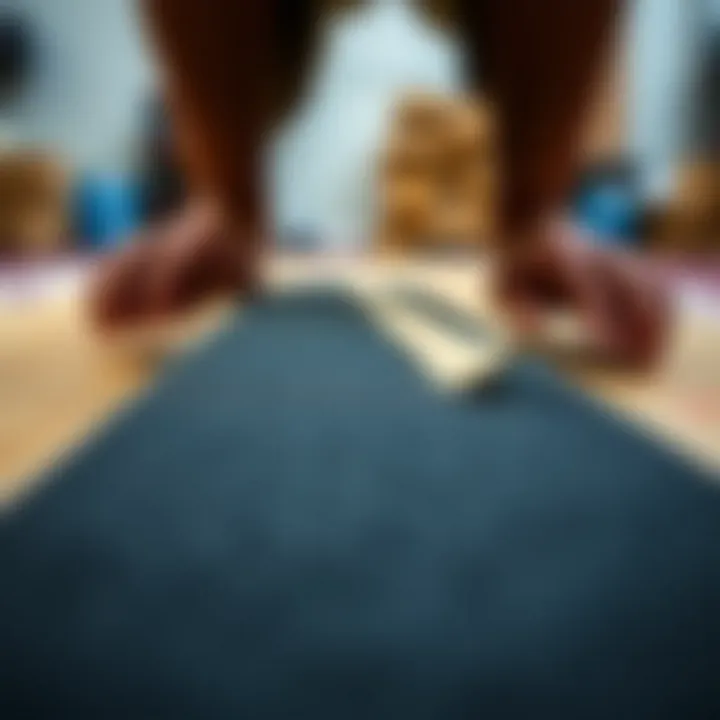
In summary, understanding the specific components like size and shape allows skaters to make informed decisions that resonate with their individual skating styles and preferences, ultimately enhancing their overall performance on the board. For further information, resources such as Wikipedia, Reddit and Britannica can provide deeper insights into the world of skateboarding.
Griptape Varieties and Designs
When it comes to skateboard decks, griptape is more than just a functional element; it’s a fundamental aspect that influences not only performance but also aesthetic expression. The varieties and designs of griptape play a significant role in how a skater interacts with their board and how that board is perceived in the larger skateboarding culture. Understanding these differences is crucial for skaters, instructors, and shop owners alike, as selecting the right griptape can elevate both performance and style.
Plain vs. Graphic Griptape
Plain griptape is often favored for its simplicity and effectiveness. Generally, it comes in black, though a range of colors may be available. Skaters who opt for plain griptape enjoy a clean, unobtrusive look that can complement any deck design. Functionally, plain griptape provides ample grip while allowing the deck graphics to remain the focus of attention. This choice can create a seamless aesthetic, making it a go-to for many.
Conversely, graphic griptape brings a dash of flair to the skateboard. This variety comes imbued with prints, patterns, and custom artworks, transforming the standard board into a canvas. Not only does graphic griptape serve the practical purpose of providing traction, but it also allows skaters to express individual style and preferences. When selecting graphic options, skaters might consider the following:
- Durability of the Print: Quality matters, as some prints fade quickly under wear and tear.
- Color Scheme Compatibility: Ensure that the graphic aligns with the deck and overall theme.
- Personal Connection: Many skaters gravitate towards designs that resonate personally, whether it’s a favorite band, artist, or cultural reference.
In a culture where identity is often expressed through gear, the choice between plain and graphic griptape can reflect not just a skater's style but also their community connections.
Custom Griptape Options
For the truly discerning skater, custom griptape options offer an opportunity to create something unique. Many brands and shops now provide tools for ordering personalized griptape, allowing skaters to upload their designs or select from customizable templates. The benefits of investing in custom griptape are numerous:
- Unique Expression: A custom design allows skaters to showcase their artistry or branding, differentiating them from the crowd.
- Enhanced Bond with Deck: When one actively designs or chooses their griptape, it can create a stronger connection to the skateboard.
- Promotional Use: For shop owners or brands, custom griptape can serve as a clever marketing tool, showcasing logos or taglines directly on the board.
Custom griptape can be a bit pricier than standard options, but for many, the investment is well worth the personalized touch. Ultimately, this custom choice underscores an important aspect of skate culture: it’s not just about the tricks or the board; it’s about the individual, their story, and how they want to share it with the world.
"Every skateboard is a reflection of its rider—the choice of griptape can tell a story that goes beyond mere function."
In summary, understanding the varieties and designs of griptape allows skaters to make informed decisions that align with their performance needs and aesthetic desires. Whether one chooses the simplicity of plain griptape or the expressive potential of graphic and custom options, each choice reflects personal taste and skating philosophy. For instructres and shop owners, knowing these nuances can facilitate better recommendations and foster deeper connections with the skateboarding community.
Installation Process
The installation process of griptape on a skateboard deck is not merely a task; it serves as a pivotal aspect that influences the performance and safety of the skateboard. An effective installation ensures optimal grip, which is crucial for executing tricks and maintaining balance. A poorly installed griptape can lead to slips, diminished control, and ultimately, a frustrating skate experience. Therefore, understanding the nuances of this process can enhance a skater's overall ride while opening up avenues for personalization.
Tools Required for Installation
Before diving into the installation, having the right tools at your disposal streamlines the process significantly. Here’s a handy list of what you will need:
- Griptape: Choose the right type that suits your style—whether plain or graphic.
- Utility Knife or Razor Blade: For cutting the griptape.
- Scissors: Useful too, although the utility knife might offer cleaner cuts.
- File or Ruler: To smooth out any rough edges post-application.
- Squeegee or Old Credit Card: To remove air bubbles while applying the griptape.
- Sandpaper: Helps in prepping the deck surface and can assist in finishing touches.
Equipping yourself with these tools eliminates unnecessary headaches during installation.
Step-by-Step Installation Guide
Preparation of the Deck
The preparation of the skateboard deck is a crucial preliminary step in the installation. Start by ensuring that the deck is clean and dry. Dust and debris can reduce the effectiveness of the adhesive that griptape relies on. You might want to use a damp cloth to wipe down the surface and, once dry, go over it with sandpaper to create a more suitable texture for the grip. Specifically, roughening the surface enables better adhesion, leading to enhanced durability and performance.
Furthermore, the key characteristic of preparing the deck is applying a disinfectant or rubbing alcohol. This unique feature minimizes any oily residue that may linger, ensuring the griptape bonds securely. Many skaters appreciate this extra precaution, as it can drastically minimize the chances of premature peeling. The meticulousness of this stage lays down the foundation for a long-lasting griptape application.
Applying Griptape
When it comes to applying the griptape, it's all about precision and care. Start by peeling off a small portion of the backing on one end of the griptape, then align it carefully with the deck. The objective is to make sure it adheres properly without significant bubbles or creases forming. As you gradually peel off the backing and press it down, utilize your squeegee or credit card for smoothing out any air bubbles that arise.
The critical component of this step is the application angle. Keeping it even ensures better grip and overall aesthetics. Skaters often lean toward this method because it allows for adjustments during the initial application. One can easily reposition the griptape before it's fully secured, accommodating the unique curves and contours of the deck. If done thoughtfully, this will enhance grip and defines the skateboard's overall look.
Trimming and Sealing Edges
After the griptape is applied, trimming and sealing edges becomes the finishing touch that affects both appearance and functionality. The key here is to ensure that the edges of the griptape are flush with the deck; this minimizes the chances of peeling or fraying. Using a utility knife or razor blade, carefully trim the excess griptape around the edges.
A unique feature to consider in this step is that you can use sandpaper to smooth the edges just after trimming. This procedure not only enhances the aesthetic quality of the board but also prevents snagging when the skater performs tricks. Many skaters find this end step beneficial, as it creates a sleek, finished look, contributing to a polished overall design.
"The small details, like sealing the edges of griptape, can be the difference between a good ride and a great one."
It’s these precise touches that transform a simple deck into a uniquely tailored skateboard ready for performance.
Maintenance of Skateboard Components
Proper maintenance of a skateboard is crucial for ensuring safety and extending the lifespan of the equipment. Every element of a skateboard, from the deck itself to the griptape, contributes to the overall performance and experience of riding. Neglecting these components can lead to undesirable outcomes, such as diminished grip, reduced control, or even serious accidents. By regularly maintaining these elements, skaters can make sure their gear keeps up with their riding style and tricks.
Cleaning the Deck
Cleaning your skateboard deck might seem like a minor chore, but it plays a pivotal role in maintaining its performance and appearance. Over time, dirt, grime, and other debris can accumulate on the surface of the deck, affecting grip and stability. A clean deck ensures that skaters can execute tricks without the risk of slips that could lead to falls.
To keep the deck in top shape:
- Use a soft brush or cloth to remove dust and grime regularly.
- If there are stubborn stains or sticky residues, a damp cloth with mild soap can do wonders.
- Always let the deck dry thoroughly after cleaning to prevent warping.
This practice not only keeps the board looking sharp but also ensures that any underlying issues, like delamination, are caught early.
Replacing Griptape
Every skater knows that griptape is the unsung hero of skateboards, but like any component, it can wear out and necessitate replacement. Recognizing when to replace the griptape can prevent mishaps during rides. Let's delve into what that looks like.
Signs of Wear and Tear
Griptape will eventually show signs of wear and tear. Knowing what to look for can help skaters make informed decisions about when to take action. Common indicators include:
- Visible cracks or peeling on edges: This affects adhesion and grip.
- Smooth patches: These areas lose their effectiveness, increasing slip risk.
- Loss of grit: When the texture starts to smooth out, it doesn’t provide the support needed for tricks.
A worn-out griptape often becomes a frustrating element of riding. Replacing it regularly not only safeguards your skateboarding tricks but also enhances the aesthetic of your board.
Removal Techniques
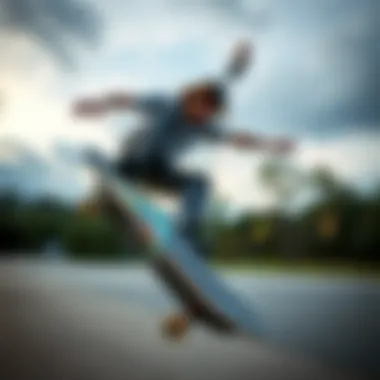

Once it's time to out with the old and in with the new, knowing how to remove the old griptape is just as important as applying the new one.
To effectively remove griptape:
- Use a heat gun or hairdryer to warm the adhesive, making it easier to peel off.
- Gently lift one corner and peel it back slowly, taking care to avoid damaging the deck underneath.
- After removal, some adhesive residue may be left behind. Use a solvent like rubbing alcohol to clean this up.
Mastering this technique allows skaters to change their griptape efficiently, keeping their board fresh and responsive without unnecessary hassle.
"Taking the time to maintain your skateboard means more enjoyable rides ahead; neglect can lead to danger and disappointment."
By paying attention to these maintenance aspects, skateboarders can ensure their equipment remains in prime condition, maximizing both safety and performance.
Safety Considerations
Skateboarding, while exhilarating, comes with its share of risks. This section underscores the importance of safety measures regarding the quality of decks and griptape. Proper attention to these elements not only enhances a skateboarder's performance but also significantly mitigates the risk of injuries.
Importance of Deck Quality
The quality of a skateboard deck plays a pivotal role in ensuring a safe skating experience. A subpar deck can lead to catastrophic failures. There are a few elements to consider when discussing deck quality:
- Material Strength: Higher-quality materials, such as Canadian maple, provide the durability needed to withstand landing tricks and everyday wear. Cheaper materials can break easily, leading to falls.
- Manufacturing Standards: Brands adhering to strict manufacturing practices will produce decks that have consistent weight distributions and structural integrity. Poorly made decks can result in unforeseen wobbles that might catch skaters off-guard.
Investing in a quality deck isn't just about performance; it's about protecting oneself from serious harm.
Griptape's Role in Safety
Griptape is not merely an aesthetic choice; it fulfills crucial safety functions that every skater must consider. The proper application of griptape can vastly improve a skater's stability and control.
Preventing Slips and Falls
Griptape plays a significant role in preventing slips and falls, serving as a reliable adhesive layer between the skateboarder's foot and the deck. The rough texture enhances friction, allowing skaters to stay firmly planted during their rides. Here’s why it’s significant:
- Key Characteristic: The abrasive surface of griptape ensures that feet won’t easily slide off, especially during tricks or landings.
- Benefits: This level of grip can make the difference between a flawless landing and an accident, allowing skaters to focus on their performance rather than worrying about their stability.
The unique feature here is the variety in griptape texture and grit levels, catering to different styles and preferences. For example, some skaters opt for finer textures for a smoother feel, while others prefer coarser options for maximum grip.
Enhanced Control During Tricks
Another vital aspect of griptape is the enhanced control it offers during tricks. With the right griptape, skaters find that they have a greater level of command over their movements. The impact on overall performance is noteworthy:
- Key Characteristic: Griptape enhances responsiveness, meaning that when a skater initiates a trick, their feet stick to the board like glue.
- Advantages: This control is crucial during complex maneuvers, as any slip could result in a nasty fall. Plus, good control often yields more consistent performances, which can be a major factor for competitive skaters.
Ultimately, quality griptape provides that extra edge that can elevate a skater’s experience from average to exceptional, giving them the confidence to push their limits. Protecting oneself from slips and ensuring precise control during tricks fosters an encouraging environment for skill development and creativity in skating.
Investing in a high-quality deck and griptape is not just smart; it's essential for anyone serious about the craft of skateboarding. Safety should never take a backseat.
Understanding these safety considerations can go a long way for skateboarders, instructors, and even shop owners in making informed choices regarding gear.
Cultural Implications of Skateboarding Gear
Skateboarding is not just a sport; it's a culture with deep roots and evolving trends that reflect the identity of its community. The skateboard deck and griptape, essential elements of this culture, contribute to how individuals express themselves on and off the board. Understanding the cultural implications surrounding these items gives insight into skateboarding's place in society and its influence both as a pastime and as a form of art.
Trends in Skateboard Design
In recent years, skateboard design has shown a fascinating blend of function and fashion. Innovative materials and shapes have emerged, catering to different styles of skating. For instance, the rise of street skateboarding encourages decks that are shorter, lighter, and more maneuverable, which allows skaters to perform tricks in urban environments. On the other hand, longboards have become popular for cruising, emphasizing stability and comfort in their longer, wider designs.
Trendy elements also extend beyond structure. Skaters often seek out unique graphic designs that set their boards apart from the rest. This practice not only makes a board visually appealing but can also reflect personal interests or beliefs. Often, graphic designs will nod to local artists or global movements, breathing life into what might otherwise be a mundane possession.
"Skateboarding is about expressing individuality, and the skateboard deck is a canvas that tells a story."
Here are a few key trends shaping skateboard design today:
- Sustainable Materials: Many manufacturers are now leaning towards eco-friendly materials, striving to reduce their carbon footprint while maintaining quality. This is critical as environmental awareness grows among skaters.
- Collaborative Designs: Collaborations between brands and famous artists or designers pump fresh ideas into the market. These limited editions can become collector's items, further enhancing the sense of community and shared culture.
- Functional Aesthetics: More skaters are favoring designs that combine utility with visual appeal, making their boards not just tools for performance but expressions of their personality.
Ultimately, trends in skateboard design reflect a broader societal movement toward personalization and self-expression.
Influence of Art and Graphics
Art and skateboarding are intertwined in a way that transcends simple aesthetics. The graphics on a skateboard deck serve as a vital means of communication within the skateboarding community. Through bold designs and themes, skaters share their stories, values, and style. In many ways, these visuals are as important as the deck itself.
Artistic expression on skateboard decks can be traced back to the dawn of the sport itself. Early skaters would paint their boards or affix stickers to express individuality. Nowadays, the industry has evolved with artists contributing professionally drawn graphics that often challenge traditional perceptions and norms.
Skateboard art often tackles a variety of themes from political statements to cultural critiques, creating a dialogue within and beyond the skate community. These designs can convey messages that resonate deeply, particularly with younger generations seeking authenticity and connection.
Some popular art styles you might find on skateboard decks include:
- Psychedelic Patterns: These vibrant visuals attract attention and provide a certain energy that resonates with many skaters.
- Minimalist Designs: Some prefer clean lines and simple color palettes, allowing for a more understated representation of style.
- Urban Art Influences: Incorporating street art elements, these boards bridge the gap between skating and other urban cultures, showcasing influences from graffiti and modern art.
Thus, the influence of art and graphics goes beyond mere decoration. It allows a means for skaters to connect, discuss, and influence their surroundings. Understanding these cultural implications provides insight into the richness of skater lifestyles.
For further reading on the cultural significance of skateboarding, consider checking resources like Wikipedia on Skateboarding or discussions on platforms like Reddit's Skateboarding community.
Finale
Reflecting on the complexities of skateboard decks and griptape emphasizes their critical roles in the performance and safety of skateboarding. Each component is not merely functional but holds significant implications for the individual skater's experience. As we have explored, choosing the right skateboard deck goes beyond mere aesthetics or trends; it involves understanding the materials, shapes, and how they cater to different styles of skating.
The importance of griptape cannot be overstated. It acts as the linchpin that connects a skater's feet to the board, enhancing stability and control. A deck might boast lightweight materials and innovative designs, but without an adequate layer of griptape, the overall performance may fall short. Griptape not only promotes safety by preventing slips and falls but also empowers skaters to execute tricks with greater precision and confidence.
In summary, recognizing the synergy between the skateboard deck and griptape is essential for both new and seasoned skaters. The right choice impacts not just your ride but also your progression and enjoyment in the sport.
Recap of Key Points
- Skateboard Decks: Tailored to various styles including cruisers, shortboards, and longboards, each has unique characteristics fit for different skateboarding approaches.
- Griptape Functions: Enhances grip and control, stability, and offers personalization options that reflect skaters’ individuality.
- Material Choices: Decks constructed from maple wood, bamboo, or plastic composites serve different needs, while griptape options include abrasive, foam, or clear variations.
- Installation and Maintenance: Emphasizing care for the board and the griptape contributes to longevity and performance.
- Safety: Choosing quality decks and effective griptape plays a pivotal role in preventing injuries and enhancing control.
Final Thoughts on Decks and Griptape
The relationship between the skateboard deck and griptape is fundamental yet often overlooked. Understanding their individual characteristics and how they harmonize unlocks a deeper appreciation for the sport. For anyone serious about their skateboarding journey—be it instructors, shop owners, or skaters themselves—spending time on these decisions is an investment in both safety and performance.



